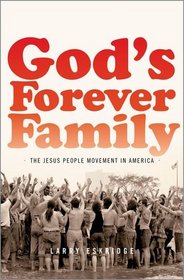Search -
God's Forever Family: The Jesus People Movement in America
God's Forever Family The Jesus People Movement in America
Author:
The Jesus People movement of the late 1960s and 1970s was an important force in the lives of millions of American Baby Boomers. This unique combination of the hippie counterculture and evangelical Christianity first appeared amid 1967's famed "Summer of Love" in San Francisco's Haight-Ashbury district and grew like wildfire in Southern Californi... more »
Author:
The Jesus People movement of the late 1960s and 1970s was an important force in the lives of millions of American Baby Boomers. This unique combination of the hippie counterculture and evangelical Christianity first appeared amid 1967's famed "Summer of Love" in San Francisco's Haight-Ashbury district and grew like wildfire in Southern Californi... more »
ISBN-13: 9780195326451
ISBN-10: 0195326458
Publication Date: 6/28/2013
Pages: 400
Rating: ?
ISBN-10: 0195326458
Publication Date: 6/28/2013
Pages: 400
Rating: ?
0 stars, based on 0 rating
Publisher: Oxford University Press, USA
Book Type: Hardcover
Members Wishing: 5
Reviews: Amazon | Write a Review
Book Type: Hardcover
Members Wishing: 5
Reviews: Amazon | Write a Review
Genres:
- History >> Americas >> United States >> 21st Century
- Categories >> Kindle eBooks >> Religion & Spirituality >> Christianity
- History >> Modern (16th-21st Centuries) >> General
- History >> Modern (16th-21st Centuries) >> 20th Century
- Religion & Spirituality >> Religious Studies >> History
- Christian Books & Bibles >> Church History
- Christian Books & Bibles >> Ministry & Evangelism >> Evangelism
- Christian Books & Bibles >> History




